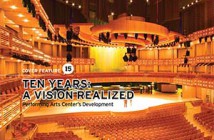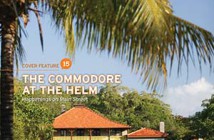South Miami’s downtown streetscape sports a mix of architectural styles, among them historically designated buildings dating from 1914 to 1955. They serve to bookend two major periods of construction activity: the feverish days of the newly “discovered” 1920s south Florida and the Post World War II boom.
Wilson A. LarkinsThe town center initially grew up near the Florida East Coast Railway station that came to what was then called the Town of Larkins about 110 years ago. Lands owned by pioneers Wilson A. Larkins, H.D. Cooper, Harold Dorn, and others were platted for buildings that would provide commercial space and living quarters in the nascent downtown. The historically designated buildings at 5800 and 5837 Sunset Drive are among those built in the 1920s at a time when the town was transitioning to a city.
The stylistic choices of architects and builders in that decade of intense construction in the Miami area were popularized by the influences of a number of national and global events. The Mission style, with its roots in the Spanish Missions of California and the Mediterranean Revival, an exuberant composite of elements from Southern Europe and Northern Africa, were translated into an American architectural language that would serve public buildings, mansions, small homes, and commercial structures with widespread appeal. This was especially true of the architectural inventory of California, Florida, and seaside resort areas spanning from the late nineteenth century and reaching its peak in the “Roaring Twenties.”
Cover of Frank Leslie’s Magazine, 1876America’s Centennial Exposition in Philadelphia from May through November 1876 rekindled an interest in the nation’s colonial past resulting in an architectural style named “Colonial Revival.” This style made its way to California, however the colonial past for them was based in the model of the Spanish Missions (1769-1823) that dotted the state. The Mission style would capture national attention at the World’s Columbian Exposition of 1893 in Chicago in Arthur Page Brown’s California State Building (a style subsequently adopted by the Santa Fe Railway for its train stations). The celebration honoring Columbus’ arrival in the New World in 1492 ran from May to October 1893, attracting about 24 million visitors.
The Mediterranean Revival style was popularized chiefly by the San Diego Panama-California Exposition of 1915-1917 that celebrated the opening of the Panama Canal on August 15, 1914. Architect Bertram Goodhue designed many of the large-scale buildings, such as the California Tower for the San Diego exposition, borrowing heavily from Spanish Baroque and Spanish Colonial examples. In Florida, the style was spread by architects such as Addison Mizner in Palm Beach and August Geiger in Miami. The Miami News and Metropolis building now known as the Freedom Tower, is an example of the Hispanic influence in American architecture as interpreted by the architectural firm of Schultze and Weaver. Built in 1925, the tower is modeled after the Giralda in Seville, Spain.
Copper California becomes California State Buildings, Panama-California Exposition by Colin Campbell Cooper, 1916. Credit Panama-California Exposition Digital Archive]Noteworthy, too is the fact that popular culture and vehicles such as magazines and the motion picture industry helped to spread the “Spanish” design fever. It was used as movie set decoration and was a favorite choice among actors and producers who purchased or commissioned Mediterranean Revival style homes. Actress Mary Pickford said that the reason she and her husband Douglas Fairbanks had chosen an architect to design a Spanish style home was in order to allow the architect (George Washington Smith) to “recreate the spirit of this day [of early California], age, people and architecture.”
Designers and builders of properties along Sunset Drive (once known by the matter-of-fact name, “County Rock Road”) chose both Mission and Mediterranean Revival architectural styles for many of Larkins/South Miami’s early buildings. The Mission style has as its primary features a central curved parapet, terra cotta roof tiles, and a stucco finish. The style is simple with minimal ornamentation. The Mediterranean Revival has as its primary features a massive quality with symmetrical façade (on commercial buildings) often with applied ornamentation, a rectangular floor plan, and arched openings. The style is eclectic and borrows from Spanish, Italian and Moorish examples.
Miami Tower State Eight becomes Miami New Times Building, 1930 [credit William Fishbaugh and Florida State Archives]The building at 5800 Sunset Drive was erected in 1929 on land owned by Wilson A. Larkins, the founder of the town. Although altered through time, most notably, the windows and storefronts, it is an example of the Mediterranean Revival style with its regularly spaced window placement, prominent parapet, raised stucco banding around the windows and parapet, and stucco finish. The east side of the two-story structure is faced in slump or Roman brick, an unusual treatment.The Shelley Building at 5837 Sunset was constructed by Robert Shelley, son of George Shelley, one of the pioneers who purchased five acres of land from a Flagler subsidiary in 1911. This survivor of South Miami’s first building boom was erected in 1926 and is best described as Mediterranean Revival with an element of the less-complex Mission style.
Shelley BuildingOriginally designed as a one-story commercial building, Mr. Shelley later added and extended the distinctive arcade on the ground floor and built a second floor with apartments. Topping the arcade was a decorative balustrade (later removed) that provided a pleasing visual break between the two floors. The second floor also sported casement windows that worked with the balustrade to balance the robust arches of the loggia below (the windows were later changed).
5800 Sunset Drive BuildingThe Shelley Building is considered to be of a Mediterranean Revival style because it features vast expanses of stucco with ornamentation limited to the doors and windows, a prominent, shaped parapet (its rounded center shape is more in keeping with the Mission style), distinctive arcade and two stories. The building first served as a grocery and dry goods store operated by Robert Shelley. His father, George operated a real estate office in one part of the store. For many years, the building had four apartments on the top floor and retail on the ground floor.
Our city enjoys a modest inventory of architecturally and historically significant structures in the downtown. Thanks to the efforts of city and county citizens, the preservation of structures representing the tastes, styles and concerns of those that came before us survive to provide our city with an identity uniquely
its own.



